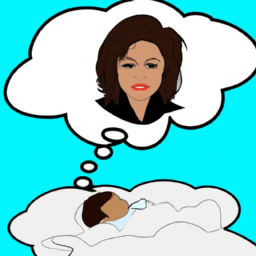Have you ever had a dream that was so vivid it stayed with you long after you woke up? Whether you were flying through the air, meeting a famous person, or reliving a difficult moment, these are all examples of vivid dreams – intense and realistic experiences that occur while we are asleep. I have read multiple articles on this topic.
Vivid dreams can be fascinating and intriguing, but they can also be confusing and even frightening. In this article, we’ll explore what vivid dreams are, their characteristics and types, as well as their causes and potential risks. We’ll also delve into the science behind these experiences and techniques for recalling and controlling them.
So let’s dive in!
Key Takeaways
- Vivid dreams are highly realistic and intense dream experiences that can offer an opportunity for self-reflection and exploration.
- Causes of vivid dreams include sleep disorders, medications, stress and anxiety, trauma, and diet.
- Management strategies for vivid dreams include therapy, relaxation techniques, good sleep hygiene, and nutritional supplements.
- Risks associated with vivid dreams include sleep deprivation, substance abuse, certain medications, and frequent nightmares.
Definition of Vivid Dreams
Vivid dreams, defined as highly realistic and intense dream experiences, have been the subject of much scientific inquiry. These types of dreams are often characterized by their lifelike quality, where one can feel like they’re actually experiencing the events in the dream.
Lucid dreaming is also a common feature of vivid dreams, where one becomes aware that they’re dreaming and can even control the events within the dream.
One way to enhance the experience of vivid dreaming is through dream journaling. Keeping a record of your dreams helps you remember them better and can also provide insight into your subconscious mind. By writing down your dreams in detail, you may begin to notice recurring themes or symbols that could hold significance for you.
Overall, vivid dreams offer a unique opportunity for self-reflection and exploration. Whether it’s through lucid dreaming or dream journaling, there are many ways to enhance these experiences and gain a deeper understanding of ourselves.
In the next section, we’ll explore some of the characteristics commonly associated with vivid dreams.
Characteristics of Vivid Dreams
You’ll feel like you’re experiencing a totally different reality when your dreams become so detailed and lifelike that you can smell, taste, and touch everything around you. These are what we call vivid dreams.
One of the characteristics of vivid dreams is lucid dreaming, where you become aware that you’re in a dream while it’s happening. In this state, you can control the events and actions in your dream to some extent.
Another characteristic of vivid dreams is their ability to leave lasting impressions on us even after we wake up. We may find ourselves pondering over the meaning behind our dreams or analyzing them for clues about our subconscious thoughts and feelings.
Dream journaling is a useful tool for capturing these impressions as soon as we wake up before they fade away from memory.
Vivid dreams are incredibly realistic experiences that can be both fascinating and unsettling at times. They may involve lucid dreaming and often leave lasting impressions on us even after we wake up. Dream journaling is an effective way to recall these experiences and gain insights into our subconscious mind.
In the next section, we’ll explore different types of vivid dreams that people commonly experience.
Types of Vivid Dreams
Get ready to discover the diverse range of intense dream experiences that people encounter, including nightmares, recurring dreams, and prophetic dreams.
One type of vivid dream that has gained much attention in recent years is lucid dreaming. In a lucid dream, the dreamer becomes aware that they are dreaming and can often manipulate the dream’s content.
Recurring dreams are another type of vivid dream experience. These are dreams that repeat themselves over time and often have a similar theme or storyline. Recurring dreams may be indicative of unresolved issues or emotions that need to be addressed in waking life.
While there are many different types of vivid dreams, each one offers its own unique experience and insight into our subconscious mind. Understanding these experiences can help us better understand ourselves and our innermost desires, fears, and concerns.
Moving forward into the subsequent section about the causes of vivid dreams, it’s important to note how these various types of vivid dreams may be influenced by certain factors in our lives.
Causes of Vivid Dreams
When I experience vivid dreams, I often wonder what might be causing them. Some of the potential culprits that come to mind include sleep disorders, medications, stress and anxiety, trauma, and diet.
As someone who values quality sleep and mental health, it’s important for me to understand the various factors that can contribute to these intense dream experiences.
In this discussion on the causes of vivid dreams, we’ll explore each of these possible triggers in more detail.
Sleep Disorders
One common sleep disorder is vivid dreams, which can be incredibly intense and realistic experiences. These dreams occur during the rapid eye movement (REM) stage of sleep, a phase where our brains are most active and engaged in processing emotions and memories. During REM sleep behavior disorder (RBD), however, individuals may act out these vivid dreams physically, potentially injuring themselves or others.
Narcolepsy symptoms may also include vivid dreams or hallucinations during sleep onset or upon awakening. These dream-like experiences can be confusing and frightening for those with narcolepsy, further interfering with their ability to get restful sleep. It is important for individuals experiencing frequent vivid dreams or other sleep disturbances to speak with a healthcare provider about potential underlying conditions and treatment options, such as medication.
Medications
You can explore various medication options to manage your sleep disorders and improve the quality of your sleep. Here are three medication options that can potentially affect vivid dreams:
- Antidepressants: Certain antidepressants such as selective serotonin reuptake inhibitors (SSRIs) and tricyclics have been known to cause vivid dreams as a side effect. It’s important to discuss this potential side effect with your doctor before starting any antidepressant medication.
- Blood Pressure Medications: Beta-blockers, which are used to treat high blood pressure, can also impact the content and intensity of dreams. This class of medications may reduce the frequency of nightmares but increase the occurrence of vivid dreams.
- Sleep Aids: Prescription sleep aids such as Ambien and Lunesta can alter dream patterns by increasing or decreasing REM sleep duration, leading to more intense or fewer dream experiences respectively. However, some studies suggest an increased risk of bizarre or disturbing dream content with these medications.
It is essential to consider possible side effects and dosage when taking medications that may impact your dreaming experience. Additionally, it’s crucial to discuss any current medication use with a healthcare provider before combining them with other drugs that could affect dream cycles due to potential interactions or contraindications.
As we move into discussing stress and anxiety in relation to vivid dreams, it’s important to note that managing these underlying conditions through therapy or relaxation techniques may be a safer alternative than solely relying on medicating for symptom relief.
Stress and Anxiety
Previously, we explored how medications can affect the vividness of our dreams. However, stress and anxiety can also play a significant role in the intensity and frequency of vivid dreams. As someone who has experienced my fair share of restless nights due to stress and anxiety, I understand how frustrating it can be to wake up feeling more drained than when you went to bed.
When we are stressed or anxious, our minds become hyperactive and overstimulated, leading to increased brain activity during sleep. This heightened brain activity can cause us to experience more vivid dreams that feel incredibly real. To help combat these intense dreams, relaxation techniques such as meditation or deep breathing exercises before bedtime can help calm the mind and reduce overall stress levels. Coping mechanisms like journaling or talking through your worries with a therapist can also be beneficial in alleviating underlying stressors that may be contributing to your vivid dreams.
As we explore further into the topic of vivid dreams, it’s important to note that traumatic experiences can also have an impact on our dream patterns.
Trauma
When experiencing trauma, it’s common for individuals to have recurring nightmares related to the event. Studies show that up to 96% of individuals who have experienced trauma report having vivid and distressing dreams. These dreams can be so intense and realistic that they can cause significant emotional distress and interfere with daily life.
PTSD therapy has been found to be effective in treating these symptoms, including techniques such as dream interpretation and exposure therapy. During PTSD therapy, a therapist may use dream interpretation as a tool to help the individual process their traumatic experiences and work through their emotions. By exploring the symbolism and themes present in their dreams, the individual can gain insight into their unconscious thoughts and feelings related to the trauma. Additionally, exposure therapy may be used to desensitize individuals to specific triggers that are causing their nightmares.
Moving on from this topic, it’s important to note that diet can also play a significant role in managing stress and promoting healthy sleep patterns.
Diet
Maintaining a healthy diet can be an effective way to manage stress and promote better sleep patterns. Eating a balanced meal that includes fruits, vegetables, whole grains, lean protein, and healthy fats can provide the necessary nutrients for our body to function properly.
Moreover, avoiding processed foods, sugary drinks, and excessive caffeine intake can help regulate our energy levels throughout the day.
In addition to healthy eating habits, nutritional supplements can also play a role in reducing stress and improving sleep quality. Certain supplements, such as magnesium, melatonin, or chamomile, have been shown to have a calming effect on the body and mind, helping us relax and fall asleep faster.
However, it’s important to consult with a healthcare professional before taking any new supplements or making significant changes to your diet.
As we explore what causes vivid dreams, it’s important to understand how our lifestyle choices impact our overall well-being. By maintaining healthy eating habits and incorporating nutritional supplements when appropriate, we can promote better sleep patterns, which may lead to more restful nights without disruptive dreams.
The Science Behind Vivid Dreams
Have you ever wondered why some dreams feel so real? The science behind vivid dreams suggests that they may be linked to increased brain activity during REM sleep.
During this stage of sleep, the brain is highly active and resembles the activity seen in a waking state. This heightened activity can lead to more vivid and intense dreams compared to those experienced during non-REM sleep.
Studies have shown that during REM sleep cycles, various regions of the brain become activated, including areas responsible for memory consolidation, emotional processing, and visual imagery. As a result, our brains are able to create rich and complex dreamscapes that feel incredibly lifelike.
Additionally, certain neurotransmitters such as serotonin and norepinephrine play a role in regulating REM sleep and may contribute to the intensity of our dreams.
Understanding the science behind vivid dreams can help us better appreciate their significance in our lives. Whether we experience pleasant or frightening scenarios in our dreams, they provide valuable insights into our emotions and thought patterns.
In the next section, we’ll explore techniques for recalling these vivid experiences upon waking up from a good night’s rest.
Techniques for Recalling Vivid Dreams
To better remember your nighttime adventures, try incorporating a dream journal into your morning routine. Journaling techniques can help you keep track of the details of your dreams and identify patterns that may emerge over time. By writing down your experiences as soon as you wake up, you are less likely to forget important details or lose the vividness of the dream.
One useful technique for recalling dreams is lucid dreaming. This involves becoming aware that you are dreaming and taking control of the experience. With practice, some people have learned to navigate their dreams and direct them towards more positive outcomes. This can lead to a greater sense of control over one’s subconscious mind and an increased ability to recall dreams in detail.
In addition to keeping a dream journal and practicing lucid dreaming, there are other tips that can help improve dream recall. These include getting plenty of sleep each night, avoiding alcohol or drugs that may interfere with sleep quality, and focusing on relaxation techniques before bed. By taking these steps, you can increase your chances of having vivid dreams that leave a lasting impression on your subconscious mind.
Transition: While improving dream recall is important for gaining insight into our subconscious minds, it’s also valuable to know how to control our dreams so we can shape our own experiences while sleeping.
Tips for Controlling Vivid Dreams
If you want to take control of your nighttime adventures, try these tips for manipulating your dream world. One way to do so is through lucid dreaming. Lucid dreaming is the ability to become aware that you’re dreaming while still in the dream state. This allows you to actively participate in and even manipulate the events of your dreams.
Another helpful tip is keeping a dream journal. Writing down your dreams immediately upon waking helps with recall and can also aid in identifying common themes or patterns that occur in your dreams. By recognizing these patterns, you can better prepare yourself for when they arise again and potentially take control of them.
Overall, controlling vivid dreams requires a combination of techniques such as lucid dreaming and dream journaling. With practice and patience, anyone can learn how to manipulate their dream world and experience all the benefits that come with it.
Speaking of benefits, let’s explore how vivid dreams can positively impact our waking lives without missing a beat!
Benefits of Vivid Dreams
Experiencing intense and immersive dreams can offer a unique form of escapism from the stresses of daily life. But beyond just being an enjoyable experience, vivid dreams can also have numerous benefits.
Here are three ways that vivid dreams can positively impact your life:
- Creative expression: Vivid dreams can act as a canvas for our subconscious minds to express themselves in creative ways. From fantastical landscapes to bizarre scenarios, these dreams allow us to tap into our inner creativity and explore new ideas without any limitations or boundaries.
- Problem solving: Our brains continue to work on problems even while we sleep, and vivid dreams provide an opportunity for this problem-solving process to take place in a more abstract way. These dreams often present us with challenges or puzzles that require creative solutions, allowing us to practice our critical thinking skills in a safe environment.
- Emotional processing: Dreams can also be a powerful tool for emotional processing and healing. They allow us to confront difficult emotions or experiences in a safe space where we have the power to control the narrative. This can lead to greater self-awareness, improved relationships, and increased overall well-being.
While there are many benefits to experiencing vivid dreams, it’s important to note that they can also come with risks if not properly managed.
In the next section, we’ll explore some potential drawbacks of intense dreaming and how best to mitigate them.
Risks of Vivid Dreams
Beware of the potential dangers that come with intense dreaming, as they can have adverse effects on your mental and physical health if left unchecked. While vivid dreams can be exciting and entertaining, they can also be a sign of underlying issues such as anxiety or trauma. Studies have shown that people who experience frequent nightmares are more likely to suffer from depression and other mental health disorders.
There are several risk factors associated with vivid dreams, including sleep deprivation, substance abuse, and certain medications. People who suffer from sleep disorders such as insomnia or sleep apnea may also be at a higher risk for experiencing intense dreams. Additionally, individuals who have experienced trauma or abuse may struggle with recurring nightmares that can cause further emotional distress.
Fortunately, there are management strategies that can help mitigate the risks associated with vivid dreaming. One approach is to create a calming bedtime routine that promotes relaxation before sleep. This could include activities such as reading a book or taking a warm bath to help ease tension in the body and reduce anxiety levels. It is also essential to maintain good sleep hygiene by avoiding caffeine and alcohol before bedtime and establishing consistent sleeping patterns.
| Risk Factors | Management Strategies |
|---|---|
| Sleep Deprivation | Establishing consistent sleeping patterns |
| Substance Abuse | Avoiding caffeine and alcohol before bedtime |
| Certain Medications | Creating a calming bedtime routine |
| Sleep Disorders | Seeking medical treatment for underlying conditions |
| Trauma or Abuse | Therapy to address emotional distress caused by nightmares |
While vivid dreams can be enjoyable experiences, it is important to recognize the potential risks associated with them. By understanding these risk factors and implementing effective management strategies, individuals can take steps towards achieving better overall mental health and wellbeing. Remember to prioritize self-care practices such as good sleep hygiene in order to promote healthy dreaming habits.
Frequently Asked Questions
Can vivid dreams be harmful?
I have experienced the potential harm of vivid dreams, from disrupted sleep to increased anxiety. Coping strategies include therapy and medication. It’s important to seek help if these dreams interfere with daily life.
How long do vivid dreams typically last?
Vivid dreams can last from a few minutes to an hour, depending on the sleep stage. Common triggers include stress, anxiety, medication, and sleep disorders. Seek medical advice if vivid dreams persist or interfere with daily activities.
Can medication or substances affect the likelihood of experiencing vivid dreams?
Medications and substances can impact the likelihood of experiencing vivid dreams. Some antidepressants, nicotine patches, and marijuana have been known to cause intense dreaming. Techniques for inducing vivid dreams intentionally include lucid dreaming practices and dream journaling.
Are there any spiritual or cultural beliefs associated with vivid dreams?
In shamanic practices, vivid dreams are believed to hold prophetic messages from the spiritual realm. Such experiences can provide insight into one’s inner self and offer guidance for personal growth.
Is it possible to induce or manipulate vivid dreams intentionally?
Yes, it is possible to induce or manipulate vivid dreams intentionally through practices such as lucid dreaming and dream journaling. These techniques require discipline and patience, but they can lead to a deeper understanding of oneself and the subconscious mind.
Conclusion
In conclusion, experiencing vivid dreams can be both fascinating and perplexing. The definition of vivid dreams is that they’re highly realistic and easily remembered by the dreamer. These types of dreams have unique characteristics that set them apart from other dreaming experiences, such as heightened emotions and sensory details.
There are several types of vivid dreams, including lucid dreaming, nightmares, and recurring dreams. While the causes of these intense dream experiences remain largely unknown, scientists have made progress in understanding the mechanisms behind them. Techniques for recalling and controlling vivid dreams exist, but they require practice to master.
One rhetorical device that adds complexity to this writing is parallelism. By using consistent structure in sentences or phrases throughout the conclusion, it emphasizes key points while also adding a sense of rhythm to the text.
Ultimately, while there may be risks associated with vivid dreaming (such as sleep disturbances), there are also many benefits to exploring this unique aspect of our subconscious mind.









